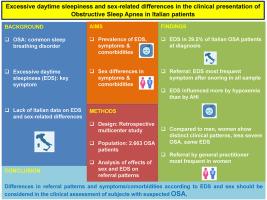Excessive daytime sleepiness and sex-related differences in the clinical presentation of obstructive sleep apnea in Italian patients
IF 3.4
2区 医学
Q1 CLINICAL NEUROLOGY
引用次数: 0
Abstract
Background
Excessive Daytime Sleepiness (EDS) is a key symptom of Obstructive Sleep Apnea (OSA). The clinical presentation of OSA differs between sexes. EDS and sex-related clinical differences were studied in Italian OSA patients.
Objectives
This multicenter study in Italian OSA patients at diagnosis assessed: 1) the EDS prevalence and its association with OSA severity, comorbidities, and other symptoms; 2) sex-related differences in clinical features of OSA.
Methods
Patient-reported data on symptoms and comorbidities were retrospectively collected from eCRF in 2663 patients (age, mean ± SD 55.7 ± 9.4 years, M 77.4 %, BMI 31.2 ± 4.6 kg/m2). EDS was defined as an Epworth Sleepiness Score >10.
Results
Overall, 39.5 % of patients reported EDS at diagnosis, especially younger and obese patients.
Referral patterns and symptoms driving OSA evaluation were affected by both occurrences of EDS and sex. OSA was more severe in patients with than without EDS. At multivariate analysis, predictors of EDS were: fatigue, subjectively impaired cognitive function, and % time spent at oxygen saturation<90 %, while being on a hypocaloric diet was protective. Women showed milder OSA severity but similar prevalence of EDS, and a different clinical phenotype and comorbidities, i.e., higher rates of fatigue, anxiety, depression, arterial hypertension, cognitive dysfunction, type 2 diabetes, gastroesophageal reflux, and asthma.
Conclusion
EDS occurred in <50 % of Italian untreated OSA patients and appeared modulated by several symptoms and hypoxemia. Compared to men, women showed similar EDS and a different pattern of symptoms/comorbidities. These findings provide insights for tailoring clinical management strategies in the Italian population.

意大利患者阻塞性睡眠呼吸暂停临床表现的日间过度嗜睡和性别相关差异
背景:白天过度嗜睡(EDS)是阻塞性睡眠呼吸暂停(OSA)的一个重要症状。阻塞性睡眠呼吸暂停的临床表现因性别而异。研究意大利OSA患者EDS与性别相关的临床差异。目的:对意大利OSA患者进行多中心研究,评估:1)EDS患病率及其与OSA严重程度、合并症和其他症状的关系;2) OSA临床特征的性别差异。方法回顾性收集2663例eCRF患者(年龄,平均±SD 55.7±9.4岁,M 77.4%, BMI 31.2±4.6 kg/m2)的患者报告的症状和合并症数据。EDS被定义为Epworth嗜睡评分10分。结果总体而言,39.5%的患者在诊断时报告EDS,特别是年轻和肥胖患者。转诊模式和驱动OSA评估的症状受EDS的发生和性别的影响。有EDS的OSA患者比无EDS的患者更严重。在多变量分析中,EDS的预测因子为:疲劳、主观上认知功能受损、血氧饱和度≥90%的时间,而低热量饮食具有保护作用。女性的OSA严重程度较轻,但EDS患病率相似,临床表型和合并症不同,即疲劳、焦虑、抑郁、动脉高血压、认知功能障碍、2型糖尿病、胃食管反流和哮喘的发生率较高。结论:50%的意大利OSA患者发生eds,并受几种症状和低氧血症的调节。与男性相比,女性表现出类似的EDS,但症状/合并症的模式不同。这些发现为在意大利人群中定制临床管理策略提供了见解。
本文章由计算机程序翻译,如有差异,请以英文原文为准。
求助全文
约1分钟内获得全文
求助全文
来源期刊

Sleep medicine
医学-临床神经学
CiteScore
8.40
自引率
6.20%
发文量
1060
审稿时长
49 days
期刊介绍:
Sleep Medicine aims to be a journal no one involved in clinical sleep medicine can do without.
A journal primarily focussing on the human aspects of sleep, integrating the various disciplines that are involved in sleep medicine: neurology, clinical neurophysiology, internal medicine (particularly pulmonology and cardiology), psychology, psychiatry, sleep technology, pediatrics, neurosurgery, otorhinolaryngology, and dentistry.
The journal publishes the following types of articles: Reviews (also intended as a way to bridge the gap between basic sleep research and clinical relevance); Original Research Articles; Full-length articles; Brief communications; Controversies; Case reports; Letters to the Editor; Journal search and commentaries; Book reviews; Meeting announcements; Listing of relevant organisations plus web sites.
 求助内容:
求助内容: 应助结果提醒方式:
应助结果提醒方式:


